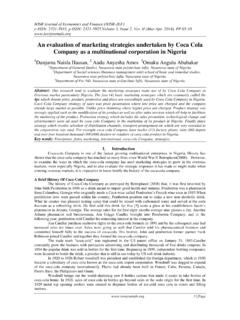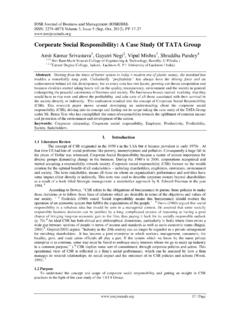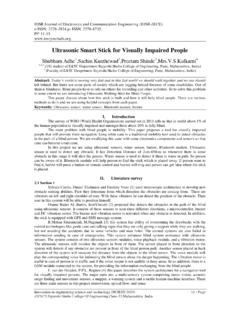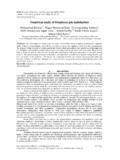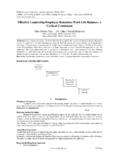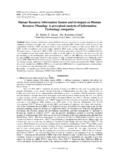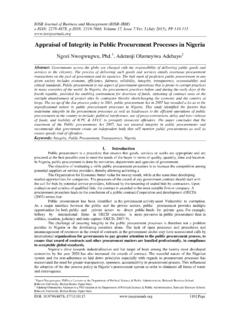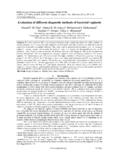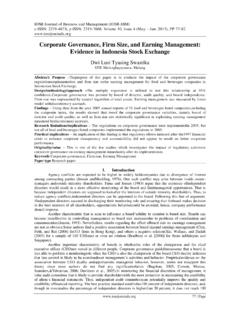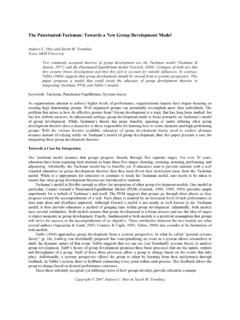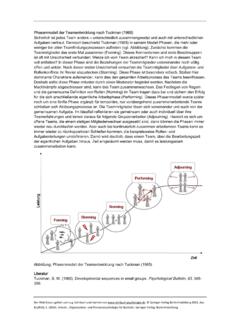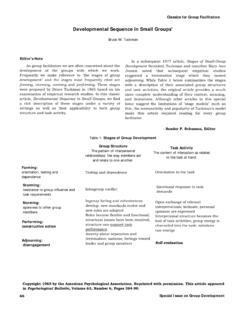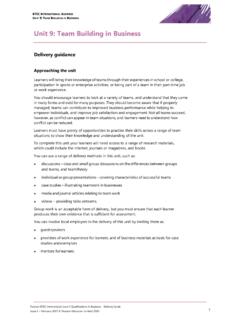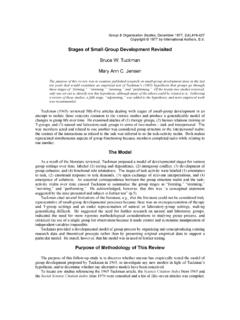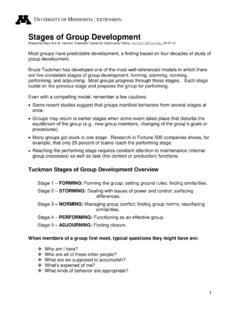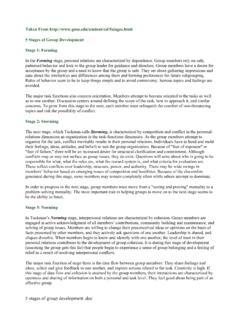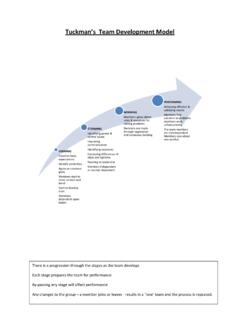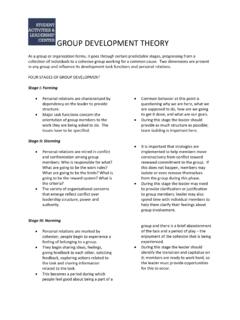Transcription of Study on Theory of Group Development; Groups and Teams
1 IOSR Journal of Business and Management (IOSR-JBM) e-ISSN: 2278-487X, p-ISSN: 2319-7668. Volume 18, Issue 2 .Ver. III (Feb. 2016), PP 58-61 DOI: 58 | Page Study on Theory of Group Development; Groups and Teams *, ** *Post Graduate in Human Resources from TISS, India, is pursuing his PhD at VIT Uuniversity, India, and holds the position of CPO at Vinayaka Missions University, India. **PhD from IIT, Madras, India, is currently the Associate Professor, at VIT University, Business School, India. Abstract: This paper traces the evolution of Group development Theory beginning with the seminal work of tuckman and thereafter. It gives an understanding how Groups are formed and what stages of development they go through to accomplish their goals. It also gives an understanding of Gersick's punctuated equilibrium, that significantly impacts the pace at which Groups work, towards accomplishing their task.
2 The paper also distinguishes between Groups and Teams . It gives an understanding of the theoretical development of Group work process focussing on natural Groups . The paper would kindle interest for empirical Study of Group development in natural Groups in corporate environment Key Words: Group development, Teams , Punctuated Equilibrium, tuckman I. Introduction Formation of Groups and their development in achieving tasks has provided an interesting arena of Study . This paper traces evolution of Theory on Group development, and also discusses the difference between Groups and Teams . The paper helps to understand the steps in Group formation, the transition that happens as Groups move towards completion of task, and also captures the distinction between Groups and Teams . tuckman 's Evolution Of Group Development Process The best known framework on Group development was developed by tuckman (1965).
3 tuckman examined 50 research papers broadly covering therapy Groups , T- Groups , natural Groups , and laboratory Groups . Based on his examination of past studies, tuckman studied the Group development from two perspectives: i. Interpersonal Group activities ii. Group task activities. In Group interpersonal activities tuckman developed a sequential progress beginning with testing and dependence, intragroup conflict, development of Group cohesion, and functional role relatedness; while in Group task activities the sequential stages are: Orientation to the task, Emotional response to task demand, Open exchange of relevant interpretations, and emergence of solutions. tuckman postulated that the Group development consisted of 4 stages, viz., Forming, Storming, Norming, and Performing. tuckman s Study suffered from certain limitations in that the past studies had more therapy Groups and less of natural Groups .
4 Further the studies were not subject to much quantitative rigour. Further Study On Group Development Process tuckman along with Mary Ann Jensen (1977) studied papers on Group development of the past 10 years to check their four step Group model Theory . They examined Science Citation Index 1965 and Social Science Citation Index 1970, and examined 57 related articles. Only Runkel s (1971) Study set out to test tuckman s hypothesis. Lucoursiere (1974) added a stage called termination, and Spitz and Sadock (1973) identified a stage called termination. Yalom (1970) had a four stage model ending with termination stage. On a review of all these studies, tuckman decided it appropriate to add the 5th and final stage to his model - adjourning. Perfect Equilibrium In Group Development Process Gersick Study (1988) presents a new Theory , on what significantly impacts the pace at which Groups work, towards accomplishing their task.
5 He studied eight Groups across six organisations. Gersick analysis of data showed that the Group had a dramatic or revolutionary change in its pace of work, almost exactly at the midpoint. Till the midpoint the Group is in a state of inertia, staying with the framework developed in the very first meeting. He saw a corollary with the concept of punctuated equilibrium in natural history Eldredge & Gould (1972). The limitations of the Study include the fact that it evolved a new hypothesis, and there was no empirical testing involved; the influence of environment as a trigger on the Group activity was noticed, but was Study on Theory of Group Development; Groups and Teams DOI: 59 | Page not studied in depth; finally, the model would only fit Teams that have an ability to change the course mid stream.
6 The research by Romanelli and tuckman (1994) was to empirically test punctuated equilibrium model in organisations, postulated by Gersick (1988). Until this Study only case histories of organisations like AT&T, General Radio, Citibank, and Prime Computers, were used to validate Gersick Study . The hypothesis that organisational negative performance would result in revolutionary transformation could not be substantiated. Otherwise analysis of data showed that change in environment, change in CEO brought about drastic changes in most parts of the organisational activity involving structure, strategy, and power distribution. Thus, Gersick s model of punctuated equilibrium was empirically tested and validated. The limitation of the Study is that the research on the model should be carried out in a more stable environment, as this Study of minicomputer producers was carried out amidst changes in technology and high competition.
7 While looking at performance and revolutionary transformation, the Study had used market share as a criteria future research should look at profitability. Other Studies On Group Development Process Heinen and Jacobson (1976 ) evolved a model for organisational task Group - Forming, Differentiation, Integration, and Full Maturity. Industry task Groups have Group goals as well as larger organisational goals set as direction for them. Jacobson model identified organisational task Groups with members active participation, communication, leadership influence, different role structures, Group goals, rewards and sanction, and external relations. Three phases of Group development are identified with the third phase being the most engaged phase. Gersick changed the understanding of Group development with his proposition of perfect equilibrium and midpoint transition.
8 Linear progression models on Group development tend to follow a gradual pattern, logical sequence, and become more effective over time. The paper by Chang, Bordia, and Duck (2003) reconciles perfect equilibrium model of Gersick and integrative model of Wheelan, taken as a representation of linear models. While the Gersick approach looked at tasks over time, integrative model looked at overall development of the Group . Gersick model would only apply to Groups that have a leeway to modify their course midway, whereas integrative model applies to all Group situations. The results confirmed that simulated Groups followed both linear model and perfect equilibrium model. Further research should streamline coding system and introduce interventions that promote socioemotional developments in simulated work Groups . Bushe and Coetzer (2007) explain how traditional Theory of Group development fit task Groups , and discuss two key sequential phases of membership and competence.
9 The paper says that Group development theories are prescriptive and development in the theories actually refer to team effectiveness. When membership of a Group is complete then focus shifts to competence that helps to achieve the Group tasks. The findings of this research show that Groups that have established membership phase show a greater cognitive congruence between as is status and the ideal status of the Group development. The traditional Theory helps to support further research on Group effectiveness. Current research argues that the most prominent models of Group development (the linear stage model and the punctuated equilibrium model) are simply different lenses for studying the same phenomenon. Bushe and Coetzer argue that the two models are distinct ( Groups do not simultaneously follow both models) and that the key to understanding their use lies in routines.
10 They studied six newly formed Groups whose members came from the same organization that worked on similar projects over a seven-week period. Three Groups worked nonmediated and three Groups used a collaboration technology that was new to them. The three nonmediated Groups followed the punctuated equilibrium model and the three collaboration technology Groups followed the stage model. They argue that Groups that enact the shared routines common in their organizations will experience a different Group development path than those Groups whose shared routines are disrupted and which must adapt to a new technology. When Group members enact shared routines (which they may share due to having a common organizational culture), they can quickly begin work, and Group development follows the punctuated equilibrium model. When Groups cannot enact shared routines, they must first negotiate how they will work before work can begin, so Group development follows the stage model.
